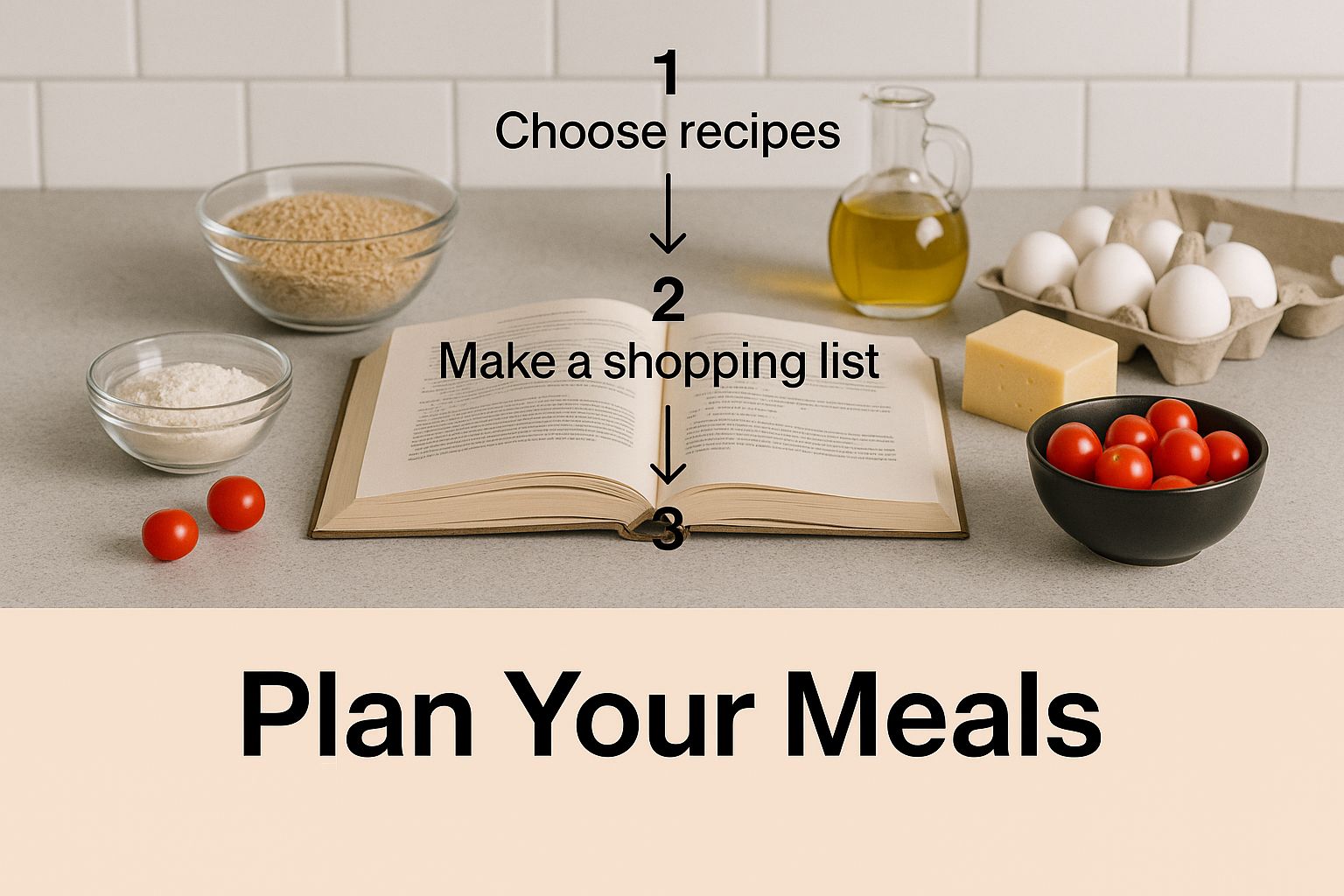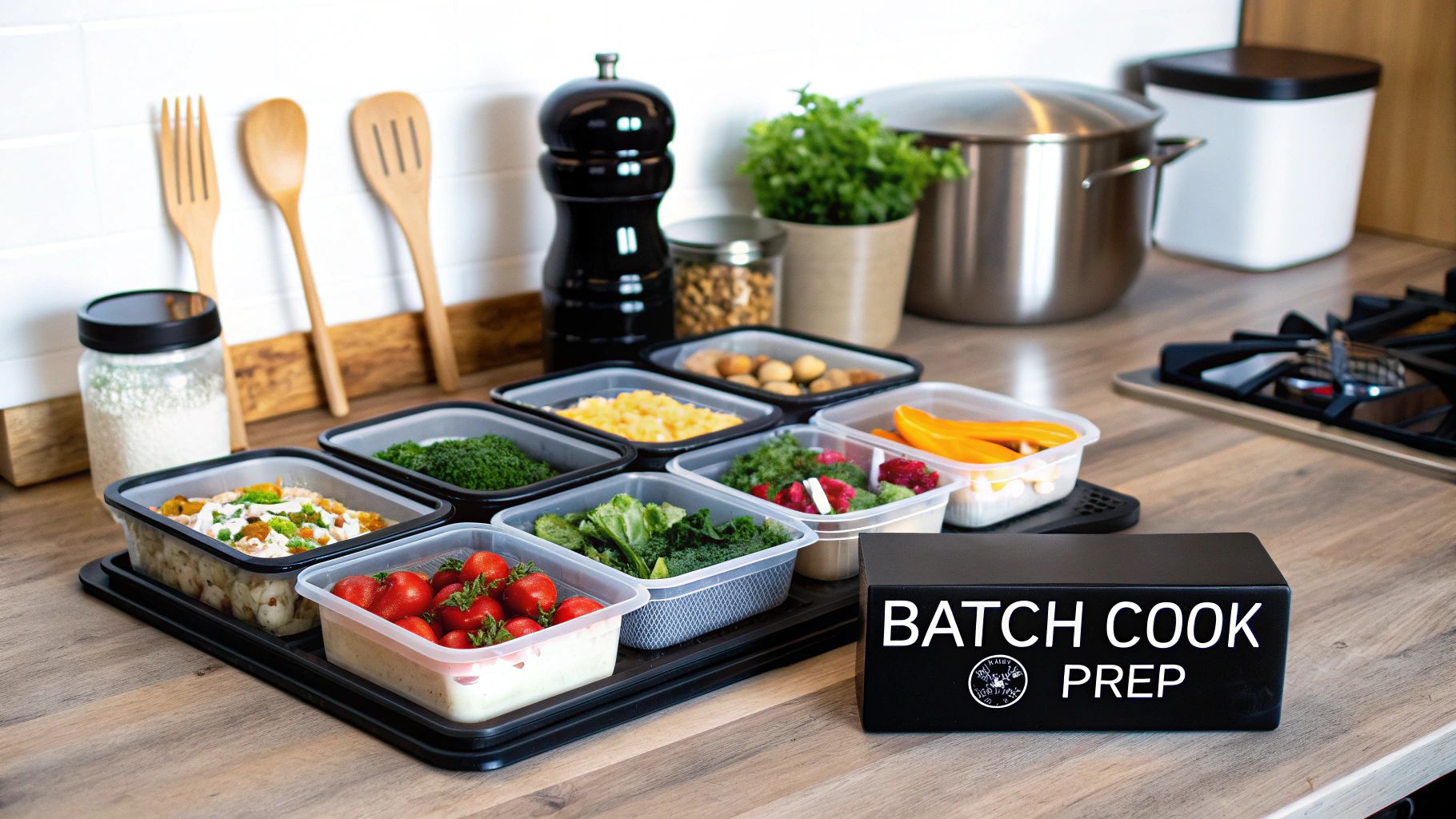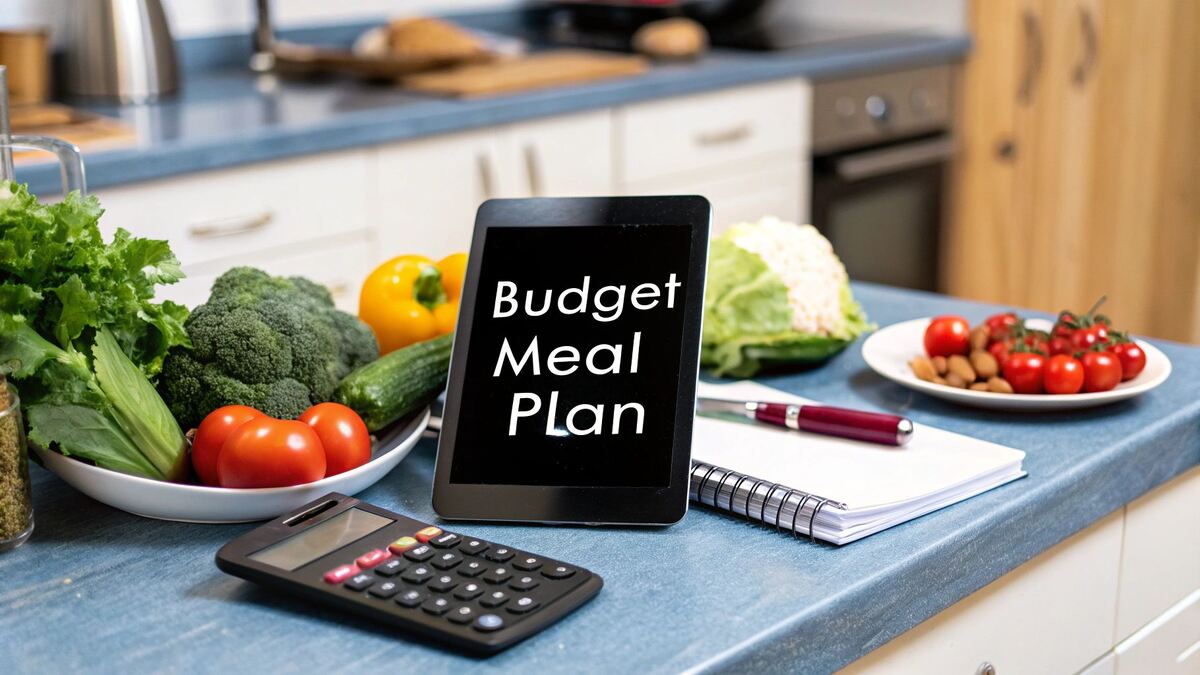How to Meal Plan on a Budget That Works
Figuring out how to meal plan on a budget is honestly simpler than it sounds. The real trick is to start with what you already have, build your meals around sale items and pantry staples, and then—this is the important part—create a shopping list you actually stick to. Just doing those three things will immediately slash impulse buys and stop food waste in its tracks.
Your Secret Weapon Against High Grocery Bills
Feeling that spike of anxiety at the grocery checkout? We've all been there. But a solid meal plan is the most effective tool you have for taking back control. It's all about shifting from that frantic, last-minute "what's for dinner tonight?" scramble to a calm, proactive strategy that puts you in the driver's seat of your spending. This isn't just about saving a few bucks; it's about reclaiming your time and your money.
Think of your meal plan as a roadmap for navigating today's high food prices without sacrificing delicious, healthy meals. Supermarkets are literally designed to make you spend more, with those tempting displays at the end of every aisle and all the cleverly placed products. A plan and a list are your best defense, helping you walk right past those marketing traps and grab only what you truly need.
The Real Cost of Unplanned Meals
The perks go way beyond just skipping that extra bag of chips. A thoughtful plan cuts down on food waste, which is like throwing money directly into the garbage can. When every onion and carrot has a purpose, you're a lot less likely to find them forgotten and wilting in the back of your crisper drawer a week later.
Before we dive into the "how-to," let's get grounded in the fundamentals. These are the four pillars that support any successful budget meal plan. Mastering these concepts from the start will make the entire process feel natural and, more importantly, sustainable.
The Four Pillars of Budget Meal Planning
| Principle | Why It Works | First Action Step |
|---|---|---|
| Shop Your Kitchen First | Prevents buying duplicates and ensures you use up what you already own, cutting waste and costs. | Spend 15 minutes taking a quick inventory of your pantry, fridge, and freezer. |
| Plan Around Sales | Basing meals on discounted proteins and produce maximizes savings on the most expensive items. | Grab your local grocery store's weekly flyer (or check their app) before planning anything. |
| Embrace Pantry Staples | Building meals from affordable, long-lasting ingredients like rice, beans, and pasta keeps costs low. | Identify 5-7 "go-to" meals your family loves that rely heavily on pantry staples. |
| Make a Detailed List | A comprehensive list eliminates impulse buys and ensures you don't forget a crucial ingredient. | Write down every single item you need for your planned meals and stick to it—no exceptions. |
Once you get these four habits down, the rest of the process becomes second nature. It’s all about creating a simple system that works for you.
The financial impact is seriously impressive. Studies show that consistent meal planning can slash a household's food budget by up to 20-30%. This is especially true when food prices are high, as a plan helps you sidestep expensive last-minute takeout and make the most of every dollar you spend. You can learn more about how global food price trends affect your wallet to see the bigger picture.
Ultimately, this whole process frees up so much mental space. Instead of stressing every single day about what to cook, you have a clear plan. This is how you start winning at the grocery store, turning a dreaded chore into a simple, budget-friendly task.
Building Your Budget Meal Plan From Scratch
Jumping into meal planning can feel overwhelming, but it doesn't have to be. The best place to start? Right in your own kitchen. Before you even glance at a recipe, take a good look at what you already have.
Seriously, open up your pantry, fridge, and freezer. What’s hiding in there? Taking a quick inventory is the single most effective first step. It’s how you avoid buying a third jar of paprika when two are already tucked away in the back.
Once you know what you're working with, you can build your plan around those ingredients. Got half a bag of lentils, some canned tomatoes, and an onion? That’s the start of a fantastic lentil soup. This "reverse" approach is the secret sauce to budget meal planning because it ensures you use up food you’ve already paid for.

Find Your Go-To Meals
To beat that "what's for dinner?" paralysis, come up with a master list of 10-15 affordable meals your family actually likes to eat. This becomes your trusted rotation, making the whole planning process way faster.
Your list should feature meals that are:
- Pantry-Powered: Think spaghetti, bean burritos, or lentil casseroles that rely on cheap, long-lasting staples.
- Easily Adaptable: A good stir-fry can work with whatever protein or vegetable is on sale that week.
- Freezer-Friendly: Soups, chilis, and casseroles are perfect for cooking in big batches and stashing away for a busy night.
With this list in hand, you’re never starting from zero. You can just plug these tried-and-true recipes into your week. For more ideas based on what you have, you could even try our AI Meal Planner to get some creative, budget-friendly suggestions.
Give Your Week Some Structure
Here’s another great trick: try theme nights. It sounds simple, but this bit of structure makes planning almost automatic and even adds some fun to the week.
Assigning themes doesn’t mean you have to be super rigid, but it gives you a helpful starting point. Think ‘Meatless Monday’ with black bean burgers, ‘Taco Tuesday’ with whatever filling is cheapest, or ‘Pasta Wednesday.’ It instantly narrows your focus and makes filling in the rest of the week a breeze.
This strategy is more important than ever. With food costs on the rise, having a plan is crucial. Food inflation in some low-income countries hit an unbelievable 30% in May 2023, which really shows how vital these budget-conscious strategies have become. By building a flexible system for yourself, you’re creating a sustainable habit that will genuinely save you money.
A Smarter Way to Shop for Groceries

Okay, you've got your meal plan. Now it's time to hit the grocery store without blowing your budget. The single most important tool you have is a well-thought-out grocery list.
Don't just scribble down what you need. I've learned to group items by aisle or store section (produce, dairy, pantry, etc.). This gives you a clear path through the store and stops you from wandering back and forth, which is prime time for impulse buys to jump into your cart.
A real game-changer is letting the weekly sales flyer guide your meal plan. Before you even decide on recipes, see what’s on sale. If chicken thighs are half-price, they're the star of the show this week, not the pricey chicken breasts.
Stick to the Store Perimeter
Here's a simple trick I swear by: do most of your shopping around the edges of the store. Think about the layout—this is where you'll almost always find the freshest, most affordable whole foods.
- Fresh Produce: Usually right when you walk in.
- Meats and Dairy: Typically along the back wall.
- Frozen Foods: Often on one of the last outer aisles.
The middle aisles are a maze of processed foods and packaged goods with higher price tags. Of course, you’ll need to pop in for things like rice, spices, or canned beans, but try to spend the bulk of your time on the perimeter. It’s better for your wallet and your health.
Another easy win is switching to store brands for your pantry staples. For items like pasta, canned tomatoes, flour, or spices, the quality is often identical to name brands, but you can see savings of 15-30% on your bill. It really adds up.
Buy in Bulk and Freeze for Later
When you spot a fantastic deal on something like ground beef or seasonal berries, don't be afraid to buy more than you need for the week. This is where a freezer becomes your best friend for locking in savings.
If you have the space, a chest freezer can be a brilliant investment for reducing food waste and capitalizing on sales. You can learn about all the benefits with these 10 surprising ways a chest freezer can save you money and make bulk buying a core part of your strategy.
Smart Cooking and Prep to Save Time and Money
A great plan is only half the battle. The real magic happens in the kitchen, where smart execution turns your budget meal plan from a good idea into a sustainable habit. A little upfront effort here will pay you back all week long, saving you from that dreaded weeknight cooking stress and the siren song of expensive takeout.

The core concept is brilliantly simple: do some of the work ahead of time. Don't worry, this doesn't mean you need to chain yourself to the stove all Sunday. Seriously, even an hour of prep can completely transform your week.
Get Comfortable With Batch Cooking
Batch cooking is your new best friend. It’s all about making larger quantities of core ingredients that you can then mix and match for different meals throughout the week. It’s probably the easiest way to dip your toes into meal prep.
For example, instead of cooking just one cup of rice for tonight's dinner, make a big pot. That rice can be a side dish on Monday, the base for a quick stir-fry on Wednesday, and the perfect filling for burritos on Friday.
Some of the best foods to batch cook are:
- Grains: A big batch of rice, quinoa, or even pasta.
- Proteins: Brown a few pounds of ground beef or cook a whole chicken to shred for tacos, soups, and salads.
- Legumes: A pot of black beans or lentils can be stretched into countless dishes.
- Vegetables: Roast a big sheet pan of chopped veggies like broccoli, carrots, and sweet potatoes.
This whole strategy is built on efficiency. By getting these staples ready at once, you slash your daily cooking and cleanup time. A little planning transforms simple ingredients into grab-and-go components for those crazy busy nights.
Live by the “Cook Once, Eat Twice” Rule
This is another powerful technique I swear by. Intentionally make larger portions of your dinner so you have planned leftovers. It's the ultimate defense against buying an overpriced lunch at work or school.
Think about it: making a double batch of chili, soup, or casserole takes almost no extra effort but gives you a whole second meal. This approach ensures nothing goes to waste and you get the most value out of every dollar you spend on groceries. To get even more efficient and make sure your prepped meals are packed with flavor, you can learn how to meal prep with BBQ rubs. It's these kinds of smart habits that make a budget meal plan actually stick.
Sticking With It When Life Gets Busy
Let's be realistic: a perfect week of following a meal plan is rare. The real test comes when life throws you a curveball. You get stuck late at work, a kid has a last-minute practice, or you're just plain exhausted. This is where most plans fall apart.
The key isn't about being perfectly rigid; it's about being consistently prepared. Knowing how to meal plan on a budget is less about the "plan" and more about having a system that bends without breaking, saving you from that knee-jerk takeout order.
Your Pantry Is Your Backup Plan
This is my secret weapon for surviving those chaotic nights. I always keep a list of three to five "emergency meals" on the fridge. These are super simple dinners I can make in under 20 minutes using ingredients I always have on hand in the pantry, freezer, or fridge.
A few of my go-to lifesavers include:
- Pasta with a jar of marinara and some frozen spinach tossed in.
- Black bean and cheese quesadillas (I keep tortillas in the freezer).
- Breakfast for dinner—scrambled eggs, toast, and whatever sad-looking vegetable is left in the crisper drawer.
They aren't going to win any culinary awards, but they're cheap, fast, and prevent a budget disaster. For more personalized ideas, our AI-powered planner can come up with suggestions based on the ingredients you actually have in your kitchen.
The most successful meal planners I know embrace the "planned-over." This isn't just eating random leftovers; it's intentionally cooking a double batch of Tuesday's chili to serve over baked potatoes on Thursday. It’s a purposeful, time-saving strategy.
And what about that sudden craving for pizza night? Don't stress about it. I just build a little wiggle room into my weekly food budget for one spontaneous meal. Another trick is to plan one ultra-cheap dinner, like a simple lentil soup, which frees up cash for a fun, unplanned meal later in the week.
It’s this kind of flexibility that turns meal planning from a chore into a habit that actually sticks.
Answering Your Meal Planning Questions
Even the best-laid plans can feel overwhelming when you're just starting out. Let's walk through some of the most common questions and sticking points that pop up when you're learning to meal plan on a budget. These are the real hurdles I've seen people (and myself!) face, and more importantly, how to get past them.
How Much Time Does This Really Take?
I'll be straight with you: your first couple of planning sessions might take up to an hour. You're getting organized, figuring out what you have, and searching for new recipes. It feels like a lot at first, but that upfront effort pays off big time by eliminating the daily "what's for dinner?" panic and those frantic, expensive, last-minute trips to the store.
The great news is that it gets so much faster. Once you build a rotation of family-favorite meals and get the hang of scanning weekly ads, the whole process becomes second nature. These days, I can map out our entire week and write my grocery list in about 20-30 minutes over a cup of coffee.
What if I Get Bored of Eating Cheap Meals?
This is a huge one. The fear of being stuck with an endless cycle of plain rice and beans is enough to make anyone quit. But "budget-friendly" absolutely does not have to mean boring. The trick is to build up your "flavor arsenal."
A well-stocked spice rack is your best friend. Simple additions like soy sauce, a good hot sauce, and different kinds of vinegar can completely change the game. The same basic chicken and rice can become a savory stir-fry one night and a zesty burrito bowl the next, all thanks to how you season it.
My favorite trick for staying sane is to plan one "fun meal" each week. It could be homemade pizza night on Fridays or trying a new recipe you've been eyeing. Building in that flexibility makes the whole thing feel sustainable, not restrictive.
How Do I Handle Picky Eaters on a Budget?
Adding picky eaters to the mix can feel like trying to solve a puzzle with half the pieces missing. I've found that the most effective strategy is deconstruction. Instead of making a complex casserole they might turn their nose up at, serve the components separately.
Here are a few tactics that have saved my sanity over the years:
- Set Up a "Build-Your-Own" Bar: Taco bars, baked potato bars, and pasta bars are absolute lifesavers. You prepare the inexpensive base (ground beef, potatoes, pasta) and set out a variety of toppings. Everyone gets to assemble a plate they'll actually enjoy.
- Let Them Have a Say: Ask your kids to help choose one or two meals for the week from a pre-approved list of budget-friendly options. When they feel involved in the planning, they are far more likely to eat the meal without a fuss.
- Stick to Familiar Foundations: Use core ingredients you know they like as the main part of the meal. You can then serve a small portion of a new vegetable on the side for them to try. It’s a low-pressure way to introduce new foods without risking a full-blown dinner meltdown or wasting money on a dish nobody touches.
Ready to stop stressing and start planning? The AI Meal Planner creates personalized, budget-friendly meal plans based on your exact needs and the ingredients you have on hand. Get your custom plan today at https://ai-mealplan.com and take the guesswork out of dinner.
AI-powered nutrition
Get Your Personalized Meal Plan
AI creates the perfect meals for your goals, lifestyle, and taste.
Start Your Journej
